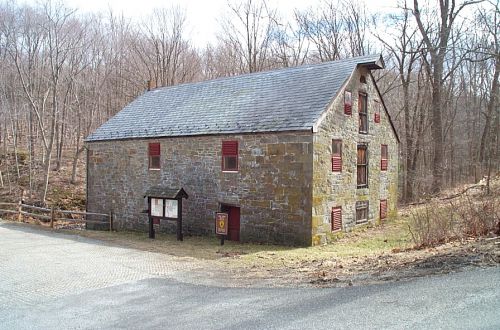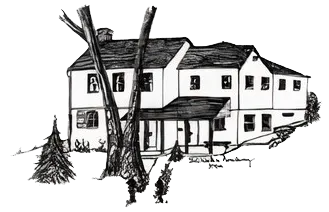HISTORY of Keen’s Grist Mill

Keen’s Grist Mill was constructed by George Keen in 1838, utilizing native stone for the foundation and exterior walls, native lumber for the structural framing and wood shingles for the roof. The Mill is located near the outlet of Swartswood Lake on the site of an earlier mill built by Charles Rhodes. Several other mills, one of which dates back to the Revolutionary War era, were also located on the site. The original dam provided a sixteen foot fall of water, which powered a seventeen foot diameter pitched back water wheel powering three grindstones. The Mill was used to grind locally grown grains.
George Keen operated the Mill until his death in 1866. His son, Joen W. Keen, appears to have operated the Mill until shortly before his death in 1889. The Mill was sold to Dr. William H. Vale of Blairstown in 1901. The Mill was acquired to control the flow of water to Blair Academy’s power station on the Paulins Kill River at Paulina. The Swartswood Lake dam burst in September, 1902. A new dam was constructed the following July. At the time, Dr. Vale renovated the Mill structure by removing the water wheel and installing a cast iron turbine and replacing doors and windows. The slate root was installed on top of the original wood shingle roof and circular sawn rafters were spliced into place behind the purlins, filling in the space between the original rafters in order to support the additional structural load. Knee walls were also constructed to shorten the span of the rafters for the additional structural load. Although no documentation could be found, it appears that the grade along the north and east elevations was raised with the construction of the 1903 dam. This is evidenced by the blocking-in of what appears to be a window and door at the basement level. The discharge from the turbine enters the Mill race approximately 35 feet south of the building. It is unknown whether this race originally extended to the south side of the building, or was constructed as part of the installation of modern machinery. No evidence remains of the internal machinery or grindstones, other than the turbine, which is located in the pit.
Early mills were the first industries in farming communities. The miller and blacksmith were traditionally early town fathers. The Miller’s office was a traditional gathering place for the farming community. Mills even served as the first town bank or post office.
It is documented that the nearby Stillwater Mill processed local grain. Flour was shipped via flat boats on the Paulinskill River to the Delaware River and to Philadelphia. The preservation of both grist and sawmills are important, in that all too many have been converted to residences, restaurants, or other uses which are not suitable for proper interpretation. The mills represented the first forms of industrial machinery in our country. Existing mills should be preserved to provide an interpretive experience of the vital role they played in the development of our communities. The Mill provides interpretation of the process of grain into flour, and how mill streams and ponds provided the energy to power the machinery.
Keen’s Grist Mill is not on either the National or State Registry of Historic Buildings.
Kevin Wright, Historic Preservation Specialist for the State Park Services, believes that the original water wheel was on the east side of the building. The axle would have entered the Mill through the stone arch in the east wall.
Results of our examination of the Mill have developed an alternative hypothesis. We believe that there is compelling evidence that the Mill orginally had an internal water wheel. The stone arched openings in the north, east and south walls all appear to be of the same period of construction. The arched opening in the north wall, facing the dam, appears to have been part of the original construction in that some of the arch stones are covered with plaster matching the plaster on the upper walls.
The north arch would have accommodated the sluiceway. The depth of the pit, the level of the original grade, as documented by the blocked door wan window openings on the lower level and the location of the tailrace arch, are the correct relationship to accommodate a seventeen foot diameter pitched back water wheel with a sixteen foot drop. The south arched opening connects the pit to the tailrace via a short tunnel. The discovery of this arched opening to the tailrace however, neither confirms nor disproves this hypothesis. The type of Pelton Wheel Turbine installed in 1903 also requires an opening from the pit to the tailrace.
- reference – Keen’s Mill Adaptive Reuse Feasibility Study Swartswood State Park Sussex County, New Jersey. Project Number. P0961-00 – Dated September 2003
